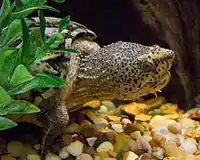loggerhead
English
WOTD – 3 April 2019
Etymology
.jpg.webp)
A flower of the common knapweed (Centaurea nigra), known in parts of the English Midlands, UK, as loggerheads (sense 4)
.jpg.webp)
.jpg.webp)
_-_Flickr_-_Andrea_Westmoreland.jpg.webp)

A loggerhead musk turtle (Sternotherus minor; sense 5.4) in the Cincinnati Zoo and Botanical Garden, Cincinnati, Ohio, USA

A loggerhead sea turtle or loggerhead turtle (Caretta caretta; sense 5.5) in the Acuario de Sevilla (Aquarium of Seville) in Seville, Andalusia, Spain
From logger (“(dialectal) heavy wooden block secured to a horse's leg to prevent it from straying”) + head.[1] Logger was apparently coined because its sound connotes a clumsy, heavy object; compare log (“trunk of a dead tree; bulky piece of wood”).[2]
Pronunciation
- (Received Pronunciation) IPA(key): /ˈlɒɡəhɛd/
- (General American) IPA(key): /ˈlɔɡɚˌhɛd/, /ˈlɑ-/
Audio (AU) (file) - Hyphenation: log‧ger‧head
Noun
loggerhead (plural loggerheads)
- (obsolete) A stupid person; a blockhead, a dolt.
- Synonyms: see Thesaurus:idiot
- c. 1595–1596, W. Shakespere [i.e., William Shakespeare], A Pleasant Conceited Comedie Called, Loues Labors Lost. […] (First Quarto), imprinted in London: By W[illiam] W[hite] for Cut[h]bert Burby, published 1598, OCLC 61366361, [Act IV, scene iii]:
- Ah, you whoreſon loggerhead, you were borne to do me ſhame.
- 1738, John Milton, “A Defence of the People of England, in Answer to Salmasius’s Defence of the King”, in A Complete Collection of the Historical, Political, and Miscellaneous Works of John Milton: […] In Two Volumes, volume I, London: Printed for A[ndrew] Millar, […], OCLC 23627242, pages 451–452:
- [Y]ou in the mean time, you ſilly Loggerhead, deſerve to have your Bones well thraſhed with a Fool's ſtaff, for thinking to ſtir up Kings and Princes to War by ſuch childiſh arguments.
- A metal tool consisting of a long rod with a bulbous end that is made hot in a fire, then plunged into some material (such as pitch or a liquid) to melt or heat it.
- 1865, James Bellew, “[Appendix D. Inland Navigations and Harbours.] Report of Mr. James Bellew, Superintendent, on the State of the Work of the Boyne Navigation. For the Year 1865. [Report no. 3676]”, in Public Works, Ireland: Thirty-fourth Report from the Board of Public Works, Ireland: With the Appendices (Reports from Commissioners; 8; volume XXIV (Sess. 1866)), Dublin: Printed by Alexander Thom, […], published 1866, OCLC 941800684, page 48, column 1:
- Stalleen Station. Four new sets of hand-rails, one new foot-board, and one new sluice have been put on. A new balance beam has been put on the guard lock, and the sluices, bearing irons, and loggerheads secured. The other works are in good order.
- 1994, Patrick O’Brian, chapter 1, in The Commodore, London: HarperCollins Publishers, published 2003, →ISBN, page 14:
- These were the two invalids in the starboard sick-berth, whom Padeen had been sitting with. They had been sparring, in a spirit of fun, with loggerheads, those massy iron balls with long handles to be carried red-hot from the fire and plunged into buckets of tar or pitch so that the substance might be melted with no risk of flame.
-
- (nautical) A post on a whaling boat used to secure the harpoon rope.
- 1851 November 14, Herman Melville, “The First Lowering”, in Moby-Dick; or, The Whale, 1st American edition, New York, N.Y.: Harper & Brothers; London: Richard Bentley, OCLC 57395299, pages 245–246:
- Not very far distant Flask's boat was also lying breathlessly still; its commander recklessly standing upon the top of the loggerhead, a stout sort of post rooted in the keel, and rising some two feet above the level of the stern platform. It is used for catching turns with the whale line. Its top is not more spacious than the palm of a man's hand, and standing upon such a base as that, Flask seemed perched at the mast-head of some ship which had sunk to all but her trucks. But little King-Post was small and short, and at the same time little King-Post was full of a large and tall ambition, so that this loggerhead stand-point of his did by no means satisfy King-Post.
-
- (botany, Midlands, dialectal, often in the plural) A thistle-like flowering plant of the genus Centaurea, particularly the common knapweed (Centaurea nigra).
- 1863, R[ichard] C[handler] A[lexander] Prior, “Loggerheads”, in On the Popular Names of British Plants, […], London; Edinburgh: Williams and Norgate, […], OCLC 20030890, page 137:
- Loggerheads, from the resemblance of its knobbed involucres to a weapon so called, consisting of a ball of iron at the end of a stick, the knapweed, the Clobbewed of old MSS. Centaurea nigra, L.
- 1866, Oswald Cockayne, compiler and editor, “Saxon Names of Worts and Trees”, in Leechdoms, Wortcunning, and Starcraft of Early England. […] (Rerum Britannicarum Medii Aevi Scriptores), volume III, London: Longmans, Green, Reader, and Dyer, OCLC 926856984, page 315, column 1:
- Bolwes, loggerheads, centaurea nigra. […] Bolwes is balls, the hard round heads of the wort. Loggerheads is a name I have often heard in Oxfordshire.
-
- (zoology) Used as the name of various animals with large heads.
- The loggerhead duck or Falkland steamer duck (Tachyeres brachypterus; formerly Tachyeres cinereus), a species of steamer duck endemic to the Falkland Islands.
- Synonym: logger duck
- 1775 November 9, William Clayton, “V. An Account of the Falkland Islands”, in Philosophical Transactions, of the Royal Society of London, volume XLVI, part I, number 446, London: Printed by W[illiam] Bowyer and J[ohn] Nichols; for Lockyer Davis, […], printer to the Royal Society, published 1776, OCLC 630046584, page 104:
- But here is a ſpecies of ducks, called the loggerhead, from its large head. They have ſhort wings, are unable to fly, and only ſwim and flap along on the water at an extraordinary rate.
- 1810 July, Jedidiah Morse, “Terra del Fuego Island”, in The American Gazetteer, Exhibiting a Full Account of the Civil Divisions, Rivers, Harbors, Indian Tribes, &c. of the American Continent: […], 3rd revised and corrected edition, Boston, Mass.: Thomas & Andrews […], OCLC 1205251:
- A ſpecies of duck, as large as a gooſe, and called the loggerhead duck at the Falkland Iſlands, is here met with, which beats the water with its wings and feet, and runs along the ſea with inconceivable velocity; […]
- 1861 April, C[harles] C[onrad] Abbott, “XV.—Notes on the Birds of the Falkland Islands”, in Philip Lutley Sclater, editor, The Ibis, a Magazine of General Ornithology, volume III, number X, London: N[icholas] Trübner and Co., […], OCLC 36672321, paragraph 42, page 161:
- Micropterus cinereus (Gm.). (Loggerhead Duck.) This Duck, which is called the ‘Loggerhead’ in the Falkland Islands, frequents the salt water. […] Looking for the Loggerhead’s eggs, which are esteemed a great delicacy, is a great amusement to all the boys in Stanley.
- The loggerhead kingbird (Tyrannus caudifasciatus), a bird endemic to the Caribbean and West Indies.
- 1863 October–November, W. T. March; S[pencer] F[ullerton] Baird, “(Communicated by the Smithsonian Institution.) Notes on the Birds of Jamaica. […]”, in Proceedings of the Academy of Natural Sciences of Philadelphia, number 6, Philadelphia, Pa.: Academy of Natural Sciences, […], OCLC 804339630, page 291:
- [E]arly in the season, a pair of Loggerheads, Tyrannus caudifasciatus, appropriated the same tree to themselves, and commenced constructing their nest. The Mocking birds were seen constantly in the square, but never interrupted or interfered with them until they had nearly completed the nest; they then drove away the Loggerheads, took possession of it, added a few sticks to the outwork, laid the eggs and hatched the young brood. The poor Loggerheads hovered about the place in great distress for a few days, but never attempted to regain possession of their property.
-
- The rufous-tailed flycatcher (Myiarchus validus), a bird endemic to Jamaica.
- 1863 October–November, W. T. March; S[pencer] F[ullerton] Baird, “(Communicated by the Smithsonian Institution.) Notes on the Birds of Jamaica. […]”, in Proceedings of the Academy of Natural Sciences of Philadelphia, number 6, Philadelphia, Pa.: Academy of Natural Sciences, […], OCLC 804339630, paragraph 50, page 288:
- Myiarchus validus, Cab. (Tyrannus crinitus, Gosse.)—The Red Petchary of the South and the Red Loggerhead of the mountains and Western districts agrees with the common Loggerhead in its general habits, except that of association; it is always found solitary, or in pairs; […]
-
- The loggerhead shrike (Lanius ludovicianus), a bird endemic to North America.
- 1879 April, T[homas] M[ayo] Brewer, “General Notes. [The Loggerhead Shrike (Colluro ludovicianus) Breeding in Northern New England.]”, in Bulletin of the Nuttall Ornithological Club: A Quarterly Journal of Ornithology, volume IV, number 2, Cambridge, Mass.: Published by the [Nuttall Ornithological] Club, ISSN 2474-0144, OCLC 962846481, page 119:
- […] I have received here also one of the parent birds, and in this instance I have been again surprised to learn that it is the Loggerhead, and not borealis or excubitoroides, that is the species referred to. […] So that we have in all ten well-authenticated instances of the Loggerhead breeding in the very heart of two of the most northerly of the New England States.
-
- The loggerhead musk turtle (Sternotherus minor), a large-headed turtle endemic to the United States.
- 1940 January, Archie Fairly Carr, Jr., “Annotated List”, in A Contribution to the Herpetology of Florida (University of Florida Biological Science Series; vol. III, no. 1), [Gainesville, Fla.]: University of Florida, OCLC 949895690, page 96:
- Sternotherus minor (Agassiz) / Loggerhead musk-turtle / […] Most numerous in large calcareous springs, where they may be seen at night wandering around on the bottom, especially about piles of debris.
- 2008, Kurl Buhlmann; Tracey Tuberville; Whit Gibbons, “Loggerhead and Striped-head Musk Turtles”, in Turtles of the Southeast (Wormsloe Foundation Nature Book), Athens, Ga.: University of Georgia Press, →ISBN, page 131:
- The loggerhead (S[ternotherus] m[inor] minor) and stripe-necked (S. m. peltifer) musk turtles represent two distinct subspecies of a species with a tan to brown carapace with black streaking and overlapping scutes down the center of the carapace. […] The head of old loggerhead musk turtles becomes disproportionately enlarged, as does the front half of the entire shell.
-
- The loggerhead sea turtle or loggerhead turtle (Caretta caretta), an oceanic turtle found throughout the world.
- 1791, Oliver Goldsmith, “Of the Tortoise, and Its Kinds”, in An History of the Earth, and Animated Nature. [...] In Eight Volumes, volume VI, new edition, London: Printed for F[rancis] Wingrave, successor to Mr. [John] Nourse, […], OCLC 877622212, part IV (Of Crustaceous and Testaceous Fishes), page 361:
- The Loggerhead is ſo called from the largeneſs of its head, which is much bigger in proportion than that of other kinds. The fleſh of this alſo is very rank, and not eaten but in caſe of neceſſity.
- 1850 November, “Leaves from the Note-book of a Naturalist. Part XI.”, in Fraser’s Magazine for Town and Country, volume XLII, number CCLI, London: John W[illiam] Parker, […], OCLC 173347075, page 548:
- [O]ur boat was hoisted out, and a loggerhead turtle struck as it was sleeping on the surface of the water. […] Dr. Patrick Browne, in his Natural History of Jamaica, mentions the hawksbill, the green turtle, and the loggerhead only. […] The loggerhead from which his description was taken was caught near the Western Islands, many leagues out at sea.
- 1987 February 20, “Affected Environment”, in Draft Supplement to the Final Environmental Impact Statement on Listing and Protecting the Green Sea Turtle, Loggerhead Sea Turtle and the Pacific Ridley Sea Turtle under the Endangered Species Act of 1973, [Washington, D.C.]: Department of Commerce, National Oceanic and Atmospheric Administration, National Marine Fisheries Service, OCLC 15869990, section III.A.1 (Loggerheads), page 33:
- The currest estimated number of loggerhead females nesting annually from North Carolina to Key Biscayne, Florida is 20,640 (± 6,328). This nesting level has been relatively stable since 1980 and accounts for about 98 percent of all loggerhead nesting within the continental United States.
-
- The loggerhead duck or Falkland steamer duck (Tachyeres brachypterus; formerly Tachyeres cinereus), a species of steamer duck endemic to the Falkland Islands.
Derived terms
- at loggerheads
- loggerheaded (adjective)
Translations
metal tool consisting of a long rod with a bulbous end
a post on a whaling boat used to secure the harpoon rope
loggerhead duck or Falkland steamer duck (Tachyeres brachypterus) — see loggerhead duck
loggerhead kingbird (Tyrannus caudifasciatus) — see loggerhead kingbird
rufous-tailed flycatcher (Myiarchus validus)
|
|
loggerhead shrike (Lanius ludovicianus) — see loggerhead shrike
loggerhead musk turtle (Sternotherus minor) — see loggerhead musk turtle
loggerhead sea turtle or loggerhead turtle (Caretta caretta) — see loggerhead sea turtle
References
- “loggerhead, n.”, in OED Online

- “logger, n.2”, in OED Online

Further reading


This article is issued from Wiktionary. The text is licensed under Creative Commons - Attribution - Sharealike. Additional terms may apply for the media files.
